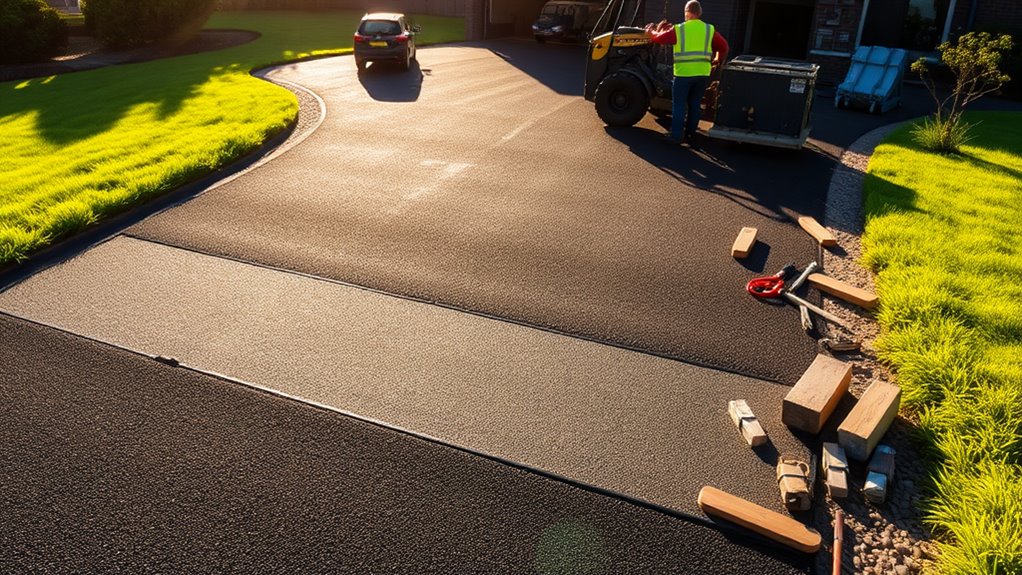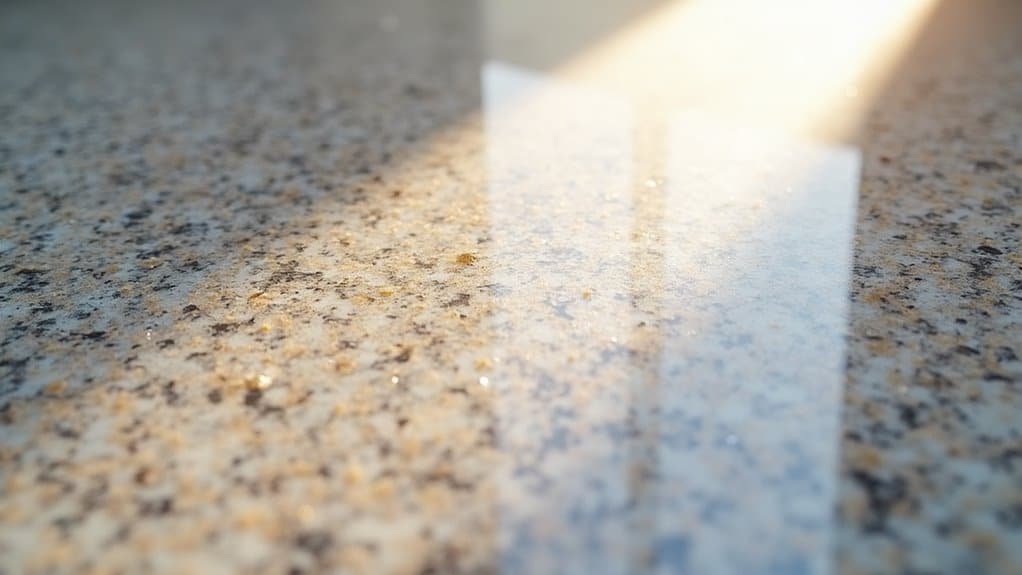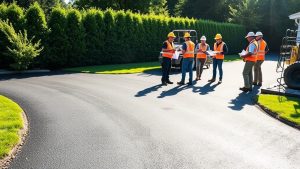Installing a tarmac driveway usually takes a few weeks. It begins with a site assessment that can take 1-2 days. After that, you'll need around 2-4 weeks to secure the necessary permits. Once that's sorted, preparing the site will take an additional 2-4 days. Laying the base takes 1-2 days, followed by the actual paving, which also requires 1-2 days. Keep in mind that weather and site conditions can affect these timelines, so it's wise to plan ahead. For a clearer understanding of each step, it's worth researching the detailed process.
Table of Contents
ToggleKey Takeaways
How Long Does It Take to Install a Tarmac Driveway?
The whole process, from initial consultation to installation, usually takes about 6-10 weeks. This timeframe can vary depending on the need for permits and the specific conditions of your site.
Site preparation, which involves clearing and grading, typically takes around 2-4 days before the paving can start.
Once that's done, installing the base layer generally requires 1-2 days, although this can vary based on the size of the driveway and site conditions.
The actual tarmac paving itself takes another 1-2 days, but this can be affected by the weather and how complex the project is.
After installation, it's advisable to allow a curing period of at least 48 hours before putting heavy loads on the driveway.
Planning and Preparation Timeline
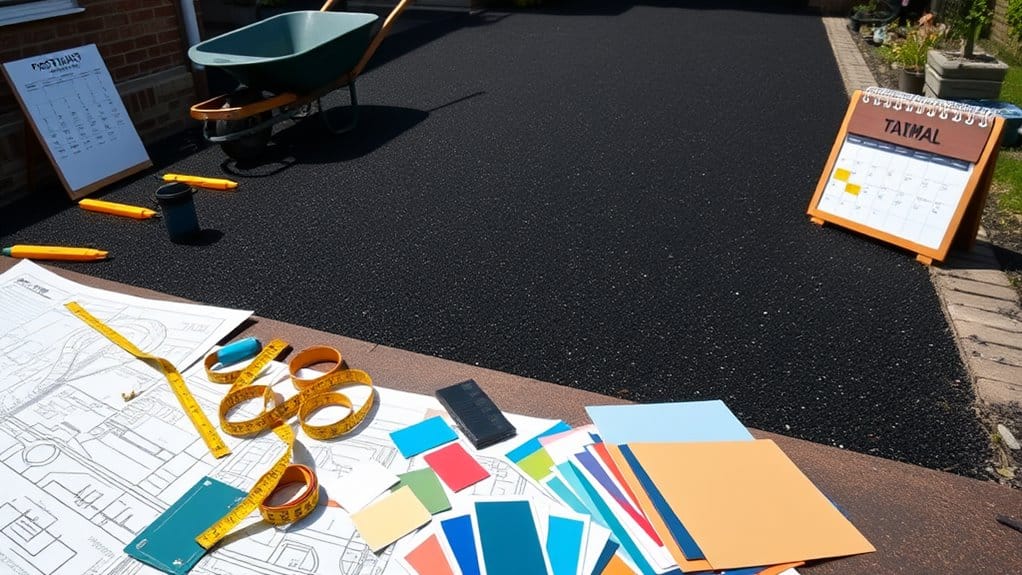
When planning to install a tarmac driveway, it's important to understand the preparation timeline.
First, you'll have a consultation period lasting 1-2 days, where the site will be assessed, and you'll receive an estimate outlining costs and timelines. Proper preparation sets the foundation for installation.
Next, you'll need to acquire the necessary permits, which usually takes 2-4 weeks to ensure compliance with local regulations. During this phase, it's crucial to mark any buried or overhead utilities to avoid damage during the installation.
Once permits are secured, scheduling the installation will depend on your availability, the weather, and the contractor's workload, typically occurring 2-4 weeks later.
This thorough planning lays the groundwork for a successful project.
Site Preparation Process
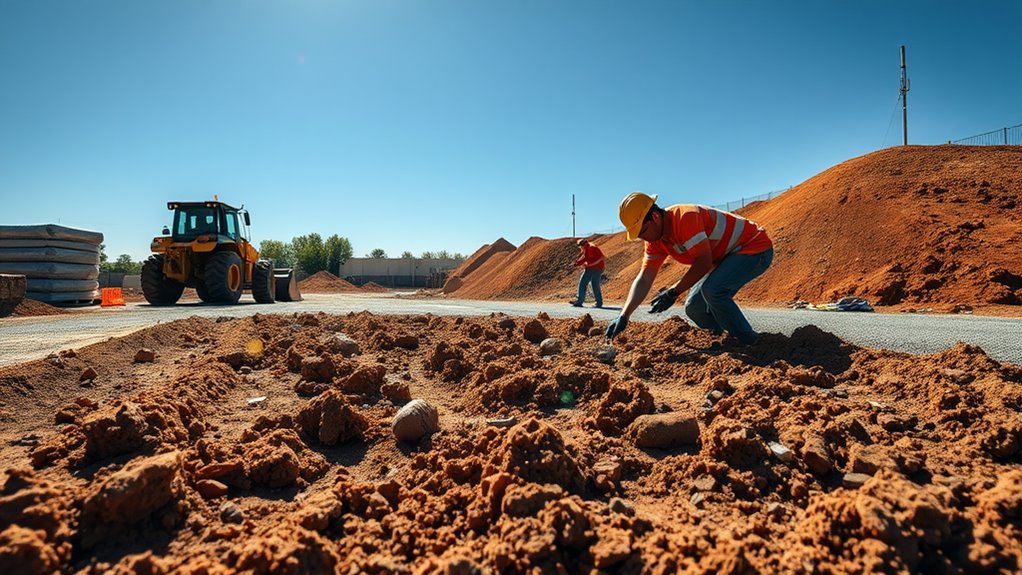
Before laying your tarmac driveway, proper site preparation is essential to ensure a stable and durable foundation. Start with a thorough site assessment to check for any existing structures or vegetation that may need addressing.
Use heavy machinery to clear the site and excavate the area, ensuring it's level and free from debris—this is crucial for both safety and efficiency. Engineers and surveyors assess the site to determine the best approach for the driveway construction.
Next, focus on grading to establish a suitable slope for drainage, which helps prevent water accumulation and potential erosion issues.
After grading, compact the soil using vibratory rollers to provide uniform support for the tarmac layers.
Throughout this process, keep machinery logistics in mind to maintain an efficient workflow. Proper site preparation is key to achieving a strong and long-lasting driveway.
Base Installation Duration
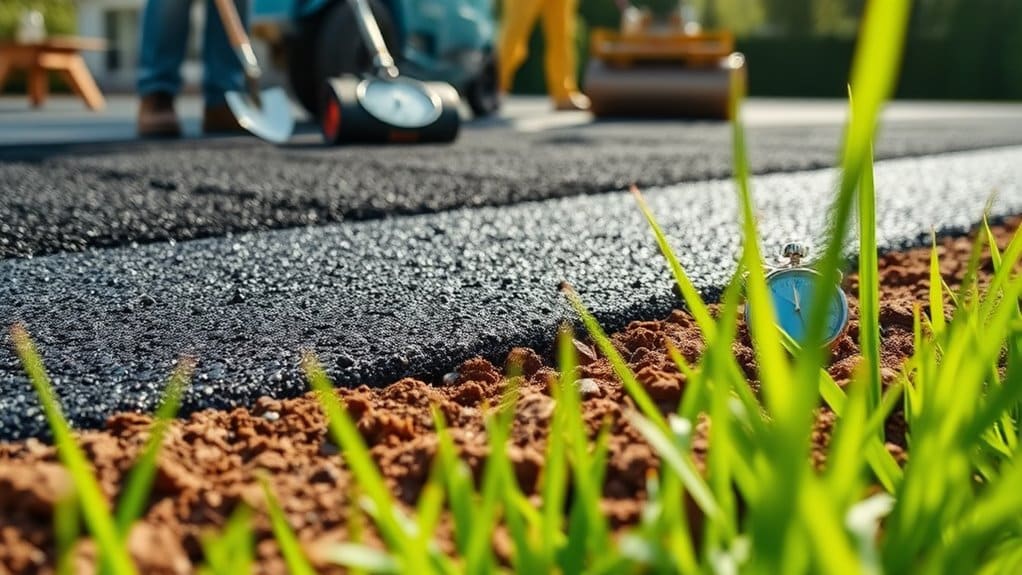
Installing the base layer for your tarmac driveway usually takes between one to two days. This timeframe can vary based on factors like the size of your driveway, the design complexity, and site conditions.
Generally, crushed stone or gravel is used as the base material, with a typical depth of 4 to 6 inches. Proper compaction is crucial to prevent uneven settling and ensure a stable surface for the asphalt. Heavy machinery or plate compactors are often used to achieve this, requiring several passes for thorough compaction.
The moisture content of the base material also plays a key role in ensuring effective compaction and the long-term durability of your driveway. Proper installation of the base is critical for longevity.
Tarmac Paving Schedule
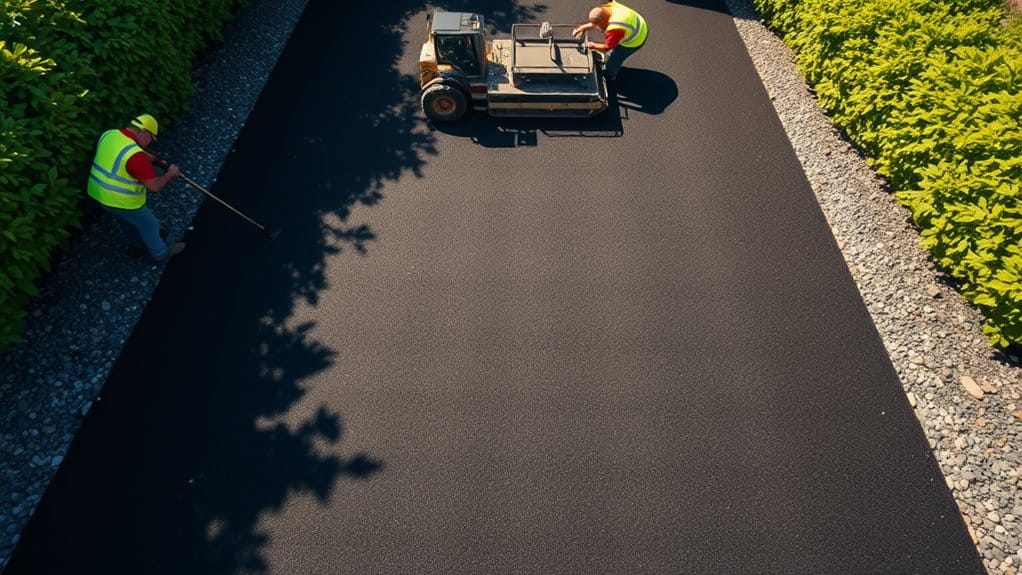
A well-organised tarmac paving schedule is vital for a smooth installation process.
Start with obtaining the necessary permits, which can take 1-2 weeks. After that, carry out a site evaluation and make design decisions.
Once approved, site preparation, including clearing and grading, usually takes 2-4 days. The actual paving, where hot asphalt is laid and compacted, typically requires 1-2 days, depending on the size of the driveway.
Keep in mind that weather can affect this timeline, so be prepared for some flexibility.
Focusing on tarmac durability during installation will lead to long-lasting results, and sticking to a maintenance routine will further extend your driveway's life.
Efficient planning and execution are crucial for a successful tarmac installation.
Setting, Curing, and Post-Installation Care
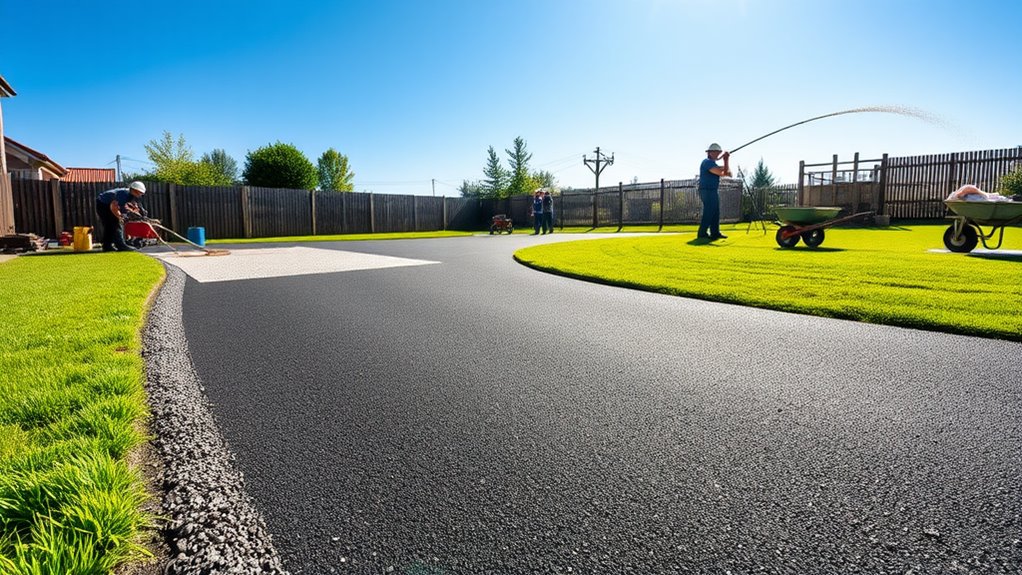
Once the tarmac is laid, it's crucial to understand the setting and curing process to achieve a durable surface. Factors such as temperature and moisture significantly affect the final strength of your driveway.
During the initial drying period, avoid heavy loads for at least 48 hours.
To ensure long-term performance, adhere to these maintenance practices:
- Regularly check for wear or damage.
- Ensure proper drainage to prevent water pooling.
- Periodically reapply seal coats to boost durability.
By paying attention to these details, you not only aid effective curing but also extend the lifespan of your tarmac driveway.
Following these guidelines will help keep your investment strong and looking good for years to come.
Frequently Asked Questions
What Factors Influence the Cost of Installing a Tarmac Driveway?
The cost of installing a tarmac driveway can vary based on several key factors. Firstly, the quality of the materials used plays a significant role; opting for higher-grade tarmac can increase costs but often results in greater durability. Secondly, the methods of installation can also affect the price—specialist techniques may be more expensive but can ensure a better finish.
Additionally, the characteristics of the site itself, such as its size, shape, and existing drainage, will influence the overall cost. For example, a larger area with uneven ground may require more preparation work, driving up expenses. Keep these factors in mind when budgeting for your driveway installation.
Can I Install a Tarmac Driveway Myself?
You can install a tarmac driveway yourself, but keep in mind that it requires some specialised equipment and a bit of technical know-how. Make sure to consider proper drainage and compaction during the installation to ensure a durable, high-quality finish. Prioritising safety is also essential. For instance, using a proper roller for compaction can make a significant difference in the longevity of your driveway.
How Do I Choose the Right Contractor for Installation?
Choosing the right contractor for your tarmac driveway installation is crucial. Start by checking their qualifications and experience in similar projects. Look for online reviews and testimonials to gauge their reputation. Make sure they hold the necessary certifications. Finally, obtain and compare quotes to ensure you're getting good value for your investment. A skilled contractor can make all the difference in the quality and longevity of your driveway.
What Are the Environmental Impacts of Tarmac Driveways?
Tarmac driveways can have notable environmental impacts, such as destroying local habitats, increasing surface water runoff, and contributing to urban heat islands. To lessen these issues, consider using recycled materials and permeable designs in your projects. This not only helps the environment but also encourages sustainable practices in your community.
How Long Does Tarmac Last Before Needing Repairs?
Curious about the lifespan of your tarmac before it needs repairs? Generally, tarmac lasts between 15 to 20 years. However, with proper maintenance, you could extend its life to around 25 years, which means fewer repairs in the long run. For instance, regular sealing and filling in cracks can significantly delay deterioration.
Conclusion
In summary, installing a tarmac driveway involves several stages, each with its own timeframe. From planning to site preparation and paving, the whole process typically takes a few days to a week, depending on your situation. It's important not to rush these steps, as doing so can lead to issues later on. Taking the time to do it properly now will ensure you have a durable, long-lasting driveway.
Prepare the perfect base for your resin bound stone installation and discover the crucial factors that ensure lasting durability.
Know where resin bound surfacing can transform spaces for both residential and commercial use, and discover the countless benefits that Read more
A stone carpet combines beauty and resilience in flooring, but what makes quartz floors uniquely beneficial? Discover the secrets behind Read more

